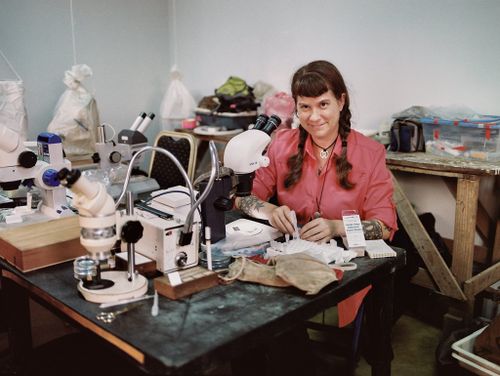Moreau, Corrie


BIOGRAPHICAL NOTE
Field Museum of Natural History Department of Zoology Division of Insects 1400 South Lake Shore Drive Chicago, IL 60605 USA Office: (312) 665-7743 FAX: (312) 665-7754 Email: cmoreau@fieldmuseum.org
Born: New Orleans, Louisiana; U.S. Citizen
POSITIONS (2008 - Forward) Assistant Curator, Field Museum of Natural History, Chicago, IL in the Department of Zoology, Division of Insects.
(2008 - Forward) Faculty Member, University of Chicago, Committee on Evolutionary Biology, Chicago, IL.
(2007 - 2008) Miller Postdoctoral Fellow at University of California, Berkeley in the Integrative Biology / Environmental Science, Policy & Management Departments working with Drs. Craig Moritz, George Roderick, and Rosemary Gillespie.
EDUCATION (2003 - 2007) Ph.D. Harvard University. Organismic and Evolutionary Biology. Dissertation project on the evolution of ants. Advisors: Drs. Naomi E. Pierce and Edward O. Wilson.
(2000 - 2003) M.A. San Francisco State University /California Academy of Sciences. Biology, Ecology and Systematics. Master’s thesis project on the molecular phylogeny of the ant subfamily Amblyoponinae. Advisors: Drs. Greg S. Spicer and Brian L. Fisher.
(1996 - 2000) B.S. San Francisco State University. Biology, Zoology concentration, Entomology emphasis.
Research Interests
Evolutionary history of the ants (Formicidae).
I am interested in the origin and evolution of species, and in particular, how different factors may influence patterns of diversification. More specifically I am interested in how we can use molecular methods and ant taxa to address these questions.
Teasing apart the factors that have lead to the prolific diversity of the ants is an active line of research in my lab. From the rise of the flowering plants, associations ants have with other insects and plants, to their microbial community are all potential underlying factors that may have facilitated their ecological dominance in almost all terrestrial ecosystems.
Moreover I am also currently pursuing research focusing on understanding biogeographic patterns and historical processes that have shaped distributions of ants in Australia and between the Nearctic and Neotropics.
Ultimately I am interested in teasing apart the evolutionary history of ants and using this information to better understand the broad-scale evolutionary patterns of life.
PUBLICATIONS
- Mezger, D.; Moreau, C. S. 2015. Out of South-East Asia: phylogeny and biogeography of the spiny ant genus Polyrhachis Smith (Hymenoptera: Formicidae). Systematic Entomology 0:1-10.
- Moreau, C. S. 2009. Inferring ant evolution in the age of molecular data (Hymenoptera: Formicidae). Myrmecological News 12:201-210.
- Moreau, C. S. 2011. What do molecular clocks tell us about the evolution of ants? American Entomologist 57:52-53.
- Moreau, C. S.; Bell, C. D. 2011. Fossil cross-validation of the dated ant phylogeny (Hymenoptera: Formicidae). Entomologica Americana 117(1/2):22-27.
- Moreau, C. S.; Bell, C. D. 2013. Testing the museum versus cradle tropical biological diversity hypothesis: phylogeny, diversification, and ancestral biogeographic range evolution of the ants. Evolution 67:2240-2257.
- Russell, J. A.; Moreau, C. S.; Goldman-Huertas, B.; Fujiwara, M.; Lohman, D. J.; Pierce, N. E. 2009. Bacterial gut symbionts are tightly linked with the evolution of herbivory in ants. Proceedings of the National Academy of Sciences of the United States of America 106:21236-21241.